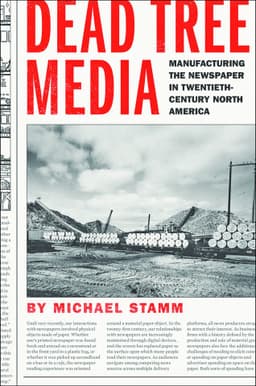
Book Review
Dead Tree Media: Manufacturing the Newspaper in Twentieth-Century North America, 2018
By Michael Stamm
Buy the book: https://www.press.jhu.edu/books/title/12038/dead-tree-media
There have been numerous studies of newspapers in North America. These typically comprise official histories, surveys of individual publications and their editorial perspectives, or the history of journalism and the experiences of editors and reporters. Comparatively rare have been examinations of how the newspaper has evolved as a business. In this volume, Michael Stamm, with a focus upon the Chicago Tribune, demonstrates how publishing formed an important and distinctive element in the emergence of managerial capitalism. The study illustrates, like the earlier research by Alfred Chandler and David Hounshell, how new technology during the late nineteenth-century propelled the expansion of companies from small plants to facilities capable of generating mass quantities. The account is concise, holistic, and sweeping, a survey of more than one hundred and twenty-five years of industrial developments based upon an impressive array of original sources.
Stamm documents how the evolution of newsprint production became a dialectical process driven by the changing content and manufacturing techniques of newspapers. It is an intriguing story of how American publishers encouraged the use of dead trees for inexpensive print media, newsprint, an orientation that propelled efforts for ever greater circulation, the development of ancillary services, and a jump to giant size either as dominant regional papers like the Tribune or as multi-site ‘chain’ organizations. The competitive profile of the enterprises compelled them to seek out reliable and ever cheaper supply sources. This, in turn, led to lobbying for an elimination of tariffs against Canadian pulp and newsprint. Contrary to expectations at the time, only a few producers from the United States eventually transferred their operations to north of the border, although financing from American sources was essential for the growth of the Canadian industry. Commodity prices nonetheless rose after 1915 which triggered a veritable war between American publishers and Canadian producers that lasted until the 1960s, as the former tried to use their market power and political clout to secure rate concessions. The largest publishers, ruthless oligopolists in their own industry, hypocritically portrayed the newsprint manufacturers as an imperious group that sought a supply monopoly and could inhibit the availability of their inexpensive ‘free press.’ Stamm summarizes how they played a critical role in the implosion that rendered much of the Canadian industry insolvent after 1927 and then how the publishers replicated those earlier initiatives by seeking out new resources in Alaska and the Southern United States. He also provides a basic overview of why and how the giant newspaper enterprises slipped into decline during the late twentieth-century, a process that led to the break-up of empires like the Tribune. Indeed, this reviewer anticipates that many readers will wish the coverage of those later developments was more extensive because they contributed to the demise of numerous Canadian forest companies.
For many Canadian historians, the ‘jewel in the crown’ of Stamm’s book will be his analysis of how a Tribune subsidiary, Quebec and Ontario Paper, developed a large operation at Baie Comeau on the north shore of the St. Lawrence River during the 1930s, which produced newsprint and a diverse group of other commodities. American direct investment critically shaped paper manufacturing in Quebec but this has never been well explored. The few available studies stress International Paper, often stereotyping that firm as a dominant firm whereas its Canadian operations actually struggled across the inter-war era. Stamm, in contrast, carefully documents the issues that propelled the Tribune to integrate backwards and to reduce its reliance upon supply purchases in the open market. His account highlights the internal contradictions of the investment: how the ‘anti-New Deal’ philosophy that the Tribune’s owner, Robert McCormick, insisted must be followed in the United States was discarded so the firm could benefit from the willingness of provincial officials to provide interventionist measures that could abet the venture. He chronicles the negotiations with the administrations of Louis-Alexandre Taschereau and Maurice Duplessis that led to a symbiotic relationship that was later propagandized as an example of how public- private partnerships should work. Stamm highlights the contradictory goals and concerns between the two sides, such as how each attempted to foster their own interests or tried to claim credit as the venture progressed. Particularly valuable is his objective account of the planning of Baie Comeau, the development of welfare capitalism and social amenities, along with the ‘shadow government’ the firm then exercised over the community. Stamm discusses at length the impact upon the incomes, occupational patterns, local services, and lifestyles of people in a remote area. He highlights how the company, like other international firms in other countries, tried to enhance social similarity and acceptance of the material values increasingly favoured in ‘modern’ urban centres, which meant retarding traditional clerical influence.
Dead Tree Media is essential reading for Canadian business historians. It provides a comprehensive account of how the rise and fall of large-scale newspapers in the United States propelled concurrent parallels in the forest industries of eastern Canada. This study highlights the futility of understanding Canadian history without a full appreciation of both the positive and negative impacts that originated from American direct investment. Generations before the North American Free Trade Accord, ‘Canadian- American business,’ by which I mean north-south flows of capital and goods, effectively redefined strategic rivalry in numerous industries to continental dimensions despite the protective measures instituted by governments. Capitalism knew no borders, while geography and changing competitive advantage could not be denied indefinitely. It is a theme that continues to dominate the global economy in the twenty-first century.
Barry E.C. Boothman
University of New Brunswick